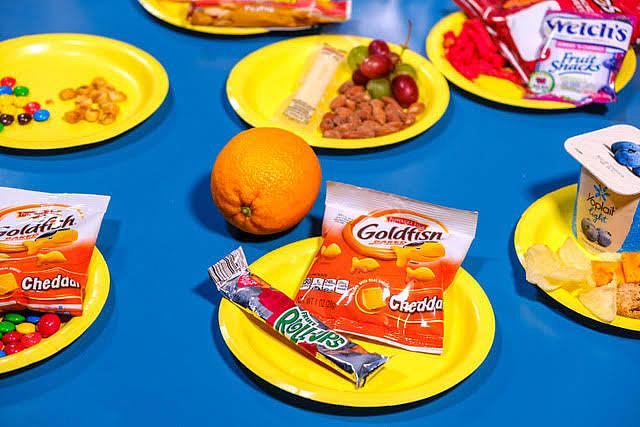Staying flexible proves key for story on junk food in LA’s afterschool programs

(Photo by Chava Sanchez/LAist)
About 45% of kids in Los Angeles County are considered to be overweight or obese, according to recent data collected by the California Department of Education. That’s compared to about 41% kids in California overall.
Monday through Friday, about 3,000 K-6 students go to afterschool programs run by the city of Los Angeles. These programs are located at about 90 recreation centers throughout the greater L.A. area. While kids are there, they get homework help, play time and a daily snack — but their snacks are mostly junk food. Chips, candy, cookies, fruit punch.
I first learned through a tip from a parent that recreation center staff believed they weren’t able to buy bottled water because of environmental reasons. The parent asked if that’s why the children were getting sugary beverages like Capri Sun pouches. So, I made a couple of calls to the Rec and Parks Department. It turned out the staff could purchase bottled water, they just didn’t know that.
Once I realized the kids were getting sugary drinks, I started to question what else are they getting — especially in light of the fact that the United States Department of Agricultural sets snack and meal nutrition guidelines for places that receive federal funding.
At this point in the story, I thought it was going to be a really easy series about how sugar is bad and what the kids were getting were bad. But as soon as I started thinking outside the box and speaking to as many people as possible, I realized there were many more pieces to the story.
The first challenge I had was finding a parent who would put their child on the record to speak about the snacks. I’m not a parent myself so I wasn’t plugged into any networks. I quickly learned that a lot of parents are active on the Nextdoor network and neighborhood-specific Facebook groups. And I also connected with my colleagues that had children in elementary school as well.
Another thing I knew I needed to do was prove that the kids were indeed being fed unhealthy snacks on a regular basis. I requested snack receipts for the 2018-2019 school year from the L.A. Recreation and Parks Department. I picked after-school programs that were in different neighborhoods with varied socioeconomic profiles, from Granada Hills to Compton. But I only received completed receipts from six sites. So, I wasn’t able to have a big sample size like I’d hoped. That was another lesson I learned, I needed to be very clear in my reporting, including spelling out our methodology in the final version. Transparency is important when reporting out a complicated story.
After analyzing the receipts, my editor and I found that around half of the combined snack budget for these sites was spent on snacks high in sugar, fat or sodium. I wanted to compare how bad these snacks were against the USDA nutrition guidelines. But the city’s afterschool programs do not use federal dollars for the snacks. I realized it was going to be challenging to do an apples to apples comparison. The USDA uses a Smart Snack Calculator to calculate if a certain food or beverage item would be deemed appropriate. But we didn’t know how afterschool programs were measuring the snacks they served, so it was hard to know how healthy they were compared to USDA standards.
As a result, I had to rethink how could I shape the story. I just started to research nutrition and food policy groups and asked their opinions on the snacks that we had compiled. I came upon one group, the Prevention Institute, that said one their website that the city of Los Angeles had passed a 2005 citywide policy, known as the Child Nutrition Policy, that set healthy nutrition guidelines for children.
This was a last-minute discovery in the reporting process, but I knew that it was pretty interesting and relevant to the story. Sometimes when reporting you think you’re arrived at a dead-end but it’s really just a detour.
I started to dig around through old city council agendas and was spraying calls out to old city council members, as well as any names that were listed in the motion. It turns out reporting on something that had happened nearly 15 years ago is difficult. Some people I called didn’t want to speak on the record or some people were retired. I really relied on archival documents and audio from council meetings back then.
I then reached out to LA’s Rec and Parks to get their response to the unhealthy snacks and beverages, and to ask if they were aware of the Child Nutrition Policy. I spoke to the department’s assistant general manager. She immediately said she remembered the Child Nutrition Policy, because she co-authored it. In her current role at Rec and Parks now she oversees the after-school programs and admitted that the city had dropped the ball.
Rec and Parks told KPCC that since I started reporting that they will re-issue the policy to staff and encourage staff to serve healthier options. Their response was a perfect example that even though you may hit many roadblocks and sometimes the story takes unexpected turns, it’s smart to take a step back, slow down and try other avenues and angles.

